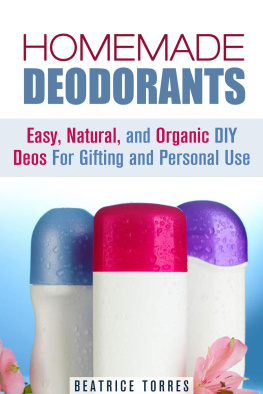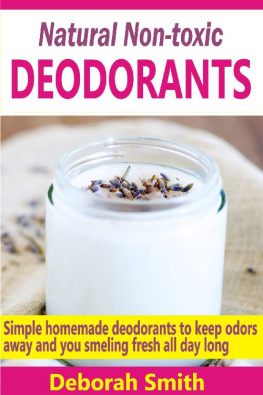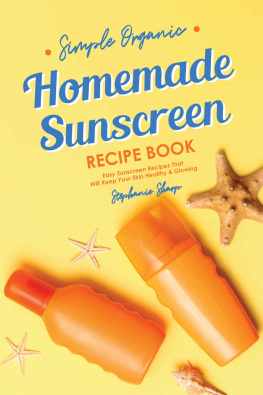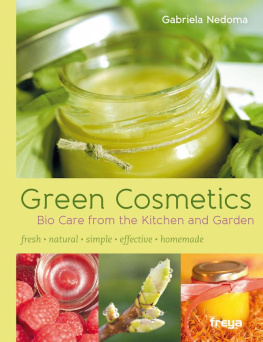Homemade Deodorants
Easy, Natural, and Organic DIY Deos For Gifting and Personal Use
Copyright Notice
Reproduction, duplication, transmission of this document in part or in whole is permitted only with written permission from the publisher. All rights reserved.
Respective brands and trademarks mentioned in this book belong to their respective owners.
Disclaimer
This document is geared towards providing summarization of information related to the topic. While all attempts have been made to verify the accuracy of the information, the author does not assume any responsibility for errors, omissions, or interpretations of the content. The information is offered for informational or entertainment purposes only. If professional advice is necessary, a qualified legal, medical, financial or another respective professional should be consulted. The reader is responsible for his or her own actions. The publisher does not accept any responsibility or liability arising from damages or losses, real or perceived, direct or indirect, resulting from the use of this information.
Table of Contents
Introduction
T he idea of homemade deodorants may seem a little absurd but the fact is that the deodorants that so many of us grab of supermarket shelves without a second thought could be doing much more harm than good. Most of us dont stop to give it a second thought when we throw a bar of our favorite deodorant into the shopping cart but the question is, would we if we knew the potential side effects of the toxins and poisons of the ingredients within them? Homemade Deodorants: Easy Natural and Organic DIY Deos For Gifting and Personal Use takes an in-depth look at the benefits of using homemade deodorants while also looking at the pitfalls of store bought deodorant bars.
Homemade Deodorants: Easy Natural and Organic DIY Deos for Gifting and Personal Use is intent on taking you into the world of homemade deodorants from learning about why you should use them to learning how you can make your own. Read on to find out how you no longer have to depend on big corporations who still utilize pesticides in your favorite deodorant brands!
Chapter One: Why Use Homemade Deodorants?
T he concept of using homemade deodorant is foreign to some and daunting to many, but there are many reasons why homemade deodorant use trumps the use of commercial products. In this chapter, we will look at why you should consider trying homemade deodorant.
In this chapter, you will learn about the following:
- Homemade deodorant means less toxin exposure
- Homemade deodorant is more cost effective
- Commercial deodorants cover up odor rather than treat it
- Homemade deodorant results in less irritation
- Commercial deodorants can be limiting
Homemade Deodorant Means Less Toxin Exposure
W hen you commit to making homemade deodorant, you have full knowledge of the ingredients that you are working with. As you read on and reach our chapter on homemade deodorant recipes, you will find that all of our recipes are comprised of simple and short ingredient lists. Take a look at any commercially produced deodorant ingredient list, and you will see a long list of ingredients, many of which are unpronounceable. Sifting through those ingredients you will find that many of them are linked to health concerns such as breast cancer these are ingredients and health concerns that we will also cover a little later in the book. With homemade deodorants, however, these types of toxins are not a concern because you control your ingredients.
Homemade Deodorant is More Cost Effective
T he ingredients used in homemade deodorants may be a little more expensive initially; however, the deodorant stick itself is not only more effective, but it is also longer lasting. Whereas commercially produced deodorants may crumble, soften and melt, many of the homemade deodorant recipes take this into account and include ingredients such as beeswax to prevent this from happening.
Commercial Deodorants Cover Up Odor Rather Than Treat It
A nother concern when it comes to commercial deodorants is that they tend to cover up odor rather than treat the source of the odor. Commercial deodorants utilize strong fragrances (that can often become old over the course of a day) to cover up odor; however, homemade deodorants include ingredients that target the source of the problem. Ingredients like coconut oil that kill off odor causing bacteria and tea tree oil that serves as a potent antibacterial are commonly included in homemade deodorants and kill off the source of the odor before applying scent to refresh.
Homemade Deodorant Results in Less Irritation
W e have already mentioned the fact that commercial deodorants include a number of toxins and irritants where homemade deodorants do not. Many times, particularly when an individual has very sensitive skin, these toxins as well as artificial ingredients contribute to irritation of the skin. This type of skin irritation can lead to redness and itching and if scratched it can soon lead to broken and bleeding skin as well.
Commercial Deodorants Can Be Limiting
L astly and perhaps not as importantly as other topics listed above, commercial deodorants are more limited than homemade deodorants. Everyone has a favorite scent but when it comes to commercially available deodorants there are only select deodorant scents available. The difference in homemade deodorants, however, is that by utilizing essential oils, you have the option to make your own scents to cater the scent of your deodorant however you like.
Chapter Two: A Closer Look at Commercial Deodorants
W e have already discussed some of the reasons why you should consider using homemade deodorants, but in this chapter we want to take a look at commercial deodorants in a little more depth. In the section below we will get a little more insight into what really goes into commercial deodorant products so that you can make a more informed decision when you compare commercial and homemade deodorant products.
In this chapter, you will learn about:
- Aluminum
- Parabens
- Propylene glycol
- Phthalates
- Triclosan
Aluminum
O ne of the main ingredients in the deodorants that you will find on store shelves is aluminum. The form of aluminum most often found in deodorants is aluminum chlorohydrate. It should be noted here that aluminum chlorohydrate is not the same as aluminum chloride, a neurotoxin, however, aluminum at high doses is capable of creating damage to DNA of the human body.
The FDA (Food and Drug Administration) has conducted numerous studies to monitor the safety of aluminum chlorohydrate in commercial deodorants and to date no increase in aluminum levels in the human body have been found from normal deodorant use (topical and inhalation exposure.) The FDA assures users of commercial deodorants that they will continue to monitor the possible effects of aluminum exposure, however. Despite these findings by the FDA, there are many who believe that aluminum exposure plays a role in the development of breast cancer in some women.
Parabens
P arabens are a class of frequently utilized preservatives throughout the cosmetic industry and are used to preserve the life of a variety of products. Some of the most recognizable parabens include methylparaben, propylparaben, butylparaben, and benzylparaben. Like aluminum, there is a belief that parabens contribute to breast cancer in some women. Some studies have been conducted that indicate that parabens build up in breast tissue; however, this test did not show that these parabens contribute to the development of cancer or cancerous tumors. Despite this finding, there are many who still believe that the buildup of parabens in breast tissue is the result of deodorant use and that this buildup has or will eventually have negative health effects.
Next page







